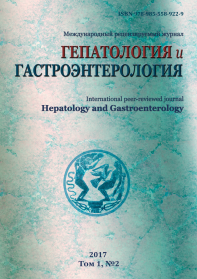CLINICAL MORPHOLOGY OF LIVER: DYSTROPHIES
Abstract
Background. Dystrophy (dys – disturbance, trophe – nourish) – morphological changes characterizing disorders of tissue and cellular metabolism, leading to structural changes.
Objective. To present the morphological signs of the most common dystrophies of the liver according to the results of biopsy and sectional material study.
Material and methods. Liver biopsy samples were obtained by performing aspiration liver biopsy in patients with chronic viral, alcoholic, toxic and metabolic liver lesions, from which a written informed consent had been received. The methods of visualization were used: electron light microscopy, including the investigation of semi-thin sections, various methods of fixation and coloring.
Results. The main types of liver dystrophies (parenchymatous – dysproteinosis or protein dystrophies: granular, hydrophilic, hyaline-droplet, lipodystrophies – acquired, hereditary, carbohydrate dystrophies – acquired, hereditary, mesenchymal or stromal – vascular – hyalinosis, amyloidosis and mixed – hemochromatosis, lipofuscinosis) and their morphological characteristics are presented.
Conclusion. Morphological study of liver biopsy samples with simultaneous application of various methods of visualization of changes in the liver enables to improve the quality of diagnostics and differential diagnostics of different types of dystrophies at different stages of development.
References
1. Strukov AI, Serov VV. Patologicheskaya anatomiya: uchebnik [Pathological anatomy: a textbook]. Paukova VS, editor. 6th ed. Moscow: GEOTAR-Media; 2015. 880 p. (Russian).
2. Canel GC, Korula J. Atlas of liver pathology. 3rd ed. Philadelphia: Elsevier; 2011. 510 p.
3. Serov VV, Severgina LO. Morfologicheskie kriterii ocenki jetiologii, stepeni aktivnosti i stadii processa pri virusnyh hronicheskih gepatitah V i S [Morphological criteria for the assessment of etiology, degree of activity and stage of the disease in viral chronic hepatitis B and C]. Arhiv patologii [Archive of Pathology]. 1996;58(4):61-64. (Russian).
4. Sato T, Takagi I. An electron microscopic study of specimen-fixed for longer periods in phosphate buffered formalin. Journal of Electron Microscopy. 1982;31(4):423-428. https://doi.org/10.1093/oxfordjournals.jmicro.a050388.
5. Glauert AM, Glauert RH. Araldite as embedding medium for electron microscopy. Journal of Biophysical and Biochemical Cytology. 1958;4(2):409-414.
6. Millonig GA. Advantages of a phosphate buffer for osmium tetroxide solutions in fixation. Journal of Applied Physics. 1961;32:1637-1643.
7. Watson ML. Staining of tissue sections for electron microscopy with heavy metals. Journal of Biophysical and Biochemical Cytology. 1958;4:475-478.
8. Glauert AM, editor. Practical Methods in Electron Microscopy. Vol. 3, Pt. 1, Glauert AM. Fixation, degydratation and embedding of biological specimens. New York: American Elsevier; 1975. 207 p.
9. Reynolds ES. The use of lead citrate at high pH as an electronopaque stain in electron microscopy. The Journal of Cell Biology. 1963;17:208-212.
10. Pokrovsky VI, Nepomnyashchikh GI, Tolokonskaya NP. Hronicheskij gepatit S: sovremennye predstavlenija o pato- i morfogeneze [Chronic hepatitis C: Modern notions of pathogenesis and morphogenesis. Concept of antiviral protection in hepatocytes]. Bjulleten jeksperimenalnoj biologii i mediciny [Bulletin of Experimental Biology and Medicine]. 2003;135(4):364-376. (Russian).
11. Mezentseva GA. Morfogenez gepatita S: alteratsiya i regeneratsiya gepatotsitov v usloviyah persistiruyuschey infektsii (patomorfologicheskoe, immunogistohimicheskoe i molekulyarno-biologicheskoe issledovanie bioptatov pecheni [Hepatitis C morphogenesis: alteration and regeneration of hepatocytes in conditions of persistent infection (pathomorphological, immunohistochemical and molecular biological study of liver biopsy specimens] [masters thesis]. Novosibirsk: Russian Academy of Medical Sciences, Siberian Branch of Russian Academy of Sciences, Scientific Research Institute of Regional Pathology and Pathomorphology, 2005. 177 p. (Russian).
12. Sheptulina AF, Nekrasova TP, Ivashkin VT. Pacientka 54 let s kozhnym zudom i gemorragicheskoj sypju [The case of 54-year-old patient with pruritus and hemorrhagic rash]. Rossijskij zhurnal gastrojenterologii, gepatologii i koloproktologii [The Russian Journal of Gastroenterology, Hepatology, Coloproctology]. 2015;6:110-117. (Russian).
13. Baker KR, Rice L. The amyloidosis: clinical features, diagnosis and treatment. Methodist DeBakey Cardiovascular Journal. 2012;8(3):3-7.
14. Makhlouf HR, Goodman ZD. Globular hepatic amyloid: an early stage in the pathway of amyloid formation: a study of 20 new cases. The American Journal of Surgical Pathology. 2007;31:1615-1621.
15. Mikhaleva LM, Gioeva ZV, Rjoken K. Gistologicheskie i immunogistohimicheskie issledovanija v diagnostike amiloidoza pecheni [Histological and immunohistochemical examinations in the diagnosis of hepatic amyloidosis]. Arhiv patologii [Archive of Pathology]. 2015;77(4):11-16. (Russian).
16. Tsimmerman YaS. Bolezn Vilsona – gepatocerebralnaja distrofija [Wilson’s disease – hepatocerebral dystrophy]. Klinicheskaja medicina [Clinical Medicine]. 2017;95(4):310-315. (Russian).
17. Tsyrkunov VM, Matsiyeuskaya NV, Lukashyk SP. HCVinfekcija [HCV-infection]. Minsk: Asar; 2012. 480 p. (Russian).
18. Tsyrkunov VM, Andreev VP, Kravchuk RI, Kandratovich IA. Klinicheskaja citologija pecheni: zvezdchatye kletki Ito [Clinical cytology of the liver: ITO stellate cells (hepatic stellate cells)]. Zhurnal Grodnenskogo gosudarstvennogo medicinskogo universiteta [Journal of the Grodno State Medical University]. 2016;4(56):90-99. (Russian).
19. Tsyrkunov VM, Andreev VP, Prokopchik NI, Kravchuk RI. Klinicheskaja morfologija pecheni: displazija, apoptoz, regeneracija [Clinical morphology of the liver: displasia, apoptosis, regeneration]. Gepatologija i gastrojenterologija [Hepatology and Gastroenterology]. 2017;1(1):41-52. (Russian).


















1.png)




